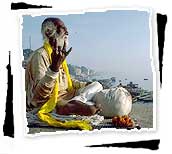The origin of the Kumbha Mela

In order to get Amrit, the drink which led to immortality, all Devtas
(lords) approach Danavas (Demons) and persuade them to perform Samudra
Manthana (churning of the sea) as it was impossible for devtas to do it
alone. Making a paddle out of Mount Mander and a rope out of serpent Anant
Nag they churned the ocean till it yielded Dhanvantri, the divine physician
who emerged holding the kumbh (pitcher) of Amrit (the nectar of life) that
could bestow immortality. As both the demons and the gods lunged for the
pot. Dhanvantri changed himself into a rook and flew off the heavens, with
the pitcher. On his journey, which lasted twelve days, he rested at four
spots-Prayag, Nasik, Ujjainn and Haridwar-which have consequently been
consecrated by drops of nectar that fell there. Therefore, these places are
considered holy by the Hindus and have become important pilgrim spots.
Sadhus
The ascetics and sadhus are an integral part of the Kumbh. One of the aims
of all devout Hindus, who make a pilgrimage to the Kumbh, is to have darshan
of these holy men. By touching their feet and listening to them, their
followers hope to gain spiritual enlightenment. The most conspicuous sadhus
at the Kumbh are the Nagas or naked sadhus. Constant exposure to the
elements and rigorous self-control makes them impervious to the extremes of
hot and cold.
The Special Attractions

The Kumbh Mela became an important meeting ground for the devout Hindus and
its importance has not diminished over the years. Even today, millions of
pilgrims from all over the world, from various walks of life, sects and
communities, gather at the Kumbh. For most it is a once-in-a-lifetime trip.
Rituals And Traditions
The main rite performed at the mela is the ritual bath. Orthodox Hindus,
who give great importance to the performance of ritualistic action, believe
that a dip in the sacred waters on the auspicious day will cleanse them and
their ancestors back to the eighty-eighth generation, off all evil and sin,
thus ensuring their salvation or freedom from the cycle of death and
rebirth. Ritual bathing is a public act and is performed in the open and
ideally on the banks of a river or stream. The most auspicious day for the
ritual bath at Kumbh is on the day of the new moon.



 In order to get Amrit, the drink which led to immortality, all Devtas
(lords) approach Danavas (Demons) and persuade them to perform Samudra
Manthana (churning of the sea) as it was impossible for devtas to do it
alone. Making a paddle out of Mount Mander and a rope out of serpent Anant
Nag they churned the ocean till it yielded Dhanvantri, the divine physician
who emerged holding the kumbh (pitcher) of Amrit (the nectar of life) that
could bestow immortality. As both the demons and the gods lunged for the
pot. Dhanvantri changed himself into a rook and flew off the heavens, with
the pitcher. On his journey, which lasted twelve days, he rested at four
spots-Prayag, Nasik, Ujjainn and Haridwar-which have consequently been
consecrated by drops of nectar that fell there. Therefore, these places are
considered holy by the Hindus and have become important pilgrim spots.
In order to get Amrit, the drink which led to immortality, all Devtas
(lords) approach Danavas (Demons) and persuade them to perform Samudra
Manthana (churning of the sea) as it was impossible for devtas to do it
alone. Making a paddle out of Mount Mander and a rope out of serpent Anant
Nag they churned the ocean till it yielded Dhanvantri, the divine physician
who emerged holding the kumbh (pitcher) of Amrit (the nectar of life) that
could bestow immortality. As both the demons and the gods lunged for the
pot. Dhanvantri changed himself into a rook and flew off the heavens, with
the pitcher. On his journey, which lasted twelve days, he rested at four
spots-Prayag, Nasik, Ujjainn and Haridwar-which have consequently been
consecrated by drops of nectar that fell there. Therefore, these places are
considered holy by the Hindus and have become important pilgrim spots.  The Kumbh Mela became an important meeting ground for the devout Hindus and
its importance has not diminished over the years. Even today, millions of
pilgrims from all over the world, from various walks of life, sects and
communities, gather at the Kumbh. For most it is a once-in-a-lifetime trip.
The Kumbh Mela became an important meeting ground for the devout Hindus and
its importance has not diminished over the years. Even today, millions of
pilgrims from all over the world, from various walks of life, sects and
communities, gather at the Kumbh. For most it is a once-in-a-lifetime trip. 



